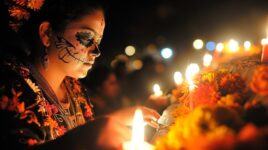
Does Guatemala Celebrate Day of the Dead
Guatemala is a country rich in tradition and cultural celebrations, and one of the most significant is the Day of the Dead. This article will explore the customs, history, and unique traditions surrounding this annual event in Guatemala. As we delve into the origins and practices associated with the Day of the Dead in Guatemala, we will uncover the various ways in which Guatemalans pay homage to their departed loved ones.
The Day of the Dead, or Día de los Muertos, is a time for Guatemalans to honor and remember their deceased family members. Despite being surrounded by festive colors and lively celebrations, this holiday holds deep meaning for those who partake in its rituals. From elaborate altars adorned with offerings to special foods and drinks prepared for the occasion, the Day of the Dead is a poignant and heartfelt commemoration.
As we venture through different aspects of this holiday, we’ll explore how Guatemalans prepare traditional dishes, create vibrant decorations, visit cemeteries, and engage in music and dance as part of their observance. We’ll also touch on regional variations that add diverse perspectives to this age-old tradition. Additionally, we will address any modern-day controversies or changes that have impacted how Guatemalans celebrate the Day of the Dead.
Join us on an immersive journey into Guatemala’s unique interpretation of the Day of the Dead as we dissect its history, customs, traditional practices, and contemporary adaptations. This exploration promises to provide insight into a revered tradition that continues to be an essential part of Guatemalan culture.
History and Origins of Day of the Dead in Guatemala
The celebration of Day of the Dead in Guatemala has deep historical and cultural roots that date back to ancient Mayan traditions. The holiday, known as “Día de los Muertos” in Spanish, is a time for Guatemalans to honor and remember their deceased loved ones. This tradition is a colorful and lively event that blends indigenous customs with Catholic influences.
The origins of Day of the Dead in Guatemala can be traced back to pre-Columbian times, when the Mayan civilization honored their ancestors through various rituals and ceremonies. With the arrival of the Spanish conquistadors in the 16th century, Catholicism became the dominant religion in Guatemala, and many indigenous customs were merged with Catholic traditions. As a result, Day of the Dead is now celebrated as a unique blend of indigenous and Christian beliefs.
During this time, it is believed that the spirits of the deceased return to earth to visit their families. To welcome them back, families create colorful altars at home and in cemeteries, adorned with photographs, candles, flowers, and traditional foods. The altars also feature offerings such as favorite foods or drinks of the departed, as well as personal items that they enjoyed in life.
This celebration serves as a way for Guatemalans to reconnect with their roots and pay homage to their ancestors. It also offers an opportunity for families to come together and share stories about their departed loved ones, keeping their memories alive through storytelling and remembrance.
Overall, the history and origins of Day of the Dead in Guatemala are deeply rooted in both ancient Mayan traditions and Catholic influences. This unique blend has created a vibrant and meaningful celebration that continues to be an important part of Guatemalan culture to this day.
- Pre-Columbian roots
- Influence of Spanish conquistadors
- Blending of indigenous customs with Catholic traditions
- Beliefs about spirits returning to earth
- The role of altars in welcoming back spirits
Traditions and Customs of Day of the Dead in Guatemala
The Day of the Dead, or Dia de los Muertos, is a widely celebrated holiday in Guatemala. It is a time for Guatemalans to honor and remember their loved ones who have passed away. The traditions and customs associated with the Day of the Dead in Guatemala are deeply rooted in Mayan and Catholic traditions, creating a unique and vibrant celebration.
One of the most well-known customs of the Day of the Dead in Guatemala is the creation of elaborate altars to honor the deceased. These altars are adorned with marigold flowers, candles, photographs of the departed, and items that were meaningful to them in life. It is believed that during this time, the spirits of the deceased return to visit their families, and the altars serve as a way to welcome them back into the home.
Another important tradition during the Day of the Dead in Guatemala is making offerings to the departed. Families prepare special meals and drinks that were favored by their loved ones, placing them on the altar as offerings. This act of offering food and drink symbolizes hospitality towards the returning spirits and demonstrates love and respect for them.
During this time, it is also common for families to visit cemeteries to decorate and clean the graves of their departed relatives. The graves are adorned with flowers, candles, and sometimes even colorful kites as a way to attract and guide the spirits back home. This tradition reflects Guatemalan’s strong belief that death does not signify an end but rather a continuation of life in another form.
In addition to these customs, Guatemalans also participate in various artistic expressions during the Day of the Dead. This includes creating intricate designs out of sawdust or colored sand called “alfombras,” which are often displayed on streets or squares as part of public celebrations. Furthermore, intricate decorations made from colored paper called “barriletes” (kites) are flown high above cemeteries as a way to communicate with departed loved ones.
Overall, these traditions and customs give insight into how Guatemalans celebrate and honor their departed loved ones during Dia de los Muertos. Each tradition serves as a way for Guatemalans to maintain connections with their ancestors while embracing both pre-Hispanic traditions and Catholic beliefs within their unique cultural heritage.
Altars and Offerings
In Guatemala, the Day of the Dead, or Día de los Muertos, is a deeply rooted and vibrant tradition that holds significant cultural and religious importance. One of the central aspects of this celebration is the creation of altars and offerings to honor departed loved ones. These altars are adorned with symbolic items and are meant to serve as a place for families to reconnect with their ancestors and pay tribute to their memories.
Symbolism and Significance
The altars created for Day of the Dead in Guatemala are rich in symbolism, with each item carefully chosen to represent different aspects of the deceased loved ones’ lives. These may include photographs of the departed, religious symbols such as crucifixes or rosaries, as well as personal belongings, favorite foods, and other items that held significance for the individual during their lifetime.
Traditional Offerings
As part of the altar preparations, families in Guatemala prepare traditional offerings known as “ofrendas” to present to their loved ones who have passed away. These offerings typically include favorite foods and beverages of the deceased, such as tamales, sweet breads, chocolates, cigarettes, and even alcoholic beverages. It is believed that by offering these items, the spirits of the departed will be nourished and comforted during their visit back to the earthly realm.
Candlelight Vigils
During Day of the Dead festivities in Guatemala, candlelight vigils are also commonly held in homes and cemeteries. The soft glow of candles is thought to guide spirits back to their families’ altars or resting places. Families gather around these altars and grave sites throughout the night, sharing stories and memories while keeping vigil over their departed loved ones.
Community Participation
While creating altars and making offerings is a deeply personal practice for many families in Guatemala, it also fosters a sense of community spirit. In some areas, neighbors come together to help each other build elaborate altars or share food for the feast that follows. This communal aspect adds an extra layer of meaning to the observance of Day of the Dead.
Continued Reverence
The reverence for departed loved ones displayed through altars and offerings during Day of the Dead in Guatemala goes beyond just a one-day event; it exemplifies a continued connection between past generations. By honoring those who have passed on through these rituals, Guatemalans keep alive cherished memories and traditions that have been passed down through generations.
Food and Drinks Associated With Day of the Dead in Guatemala
Day of the Dead is one of the most significant and colorful celebrations in Guatemala, with a unique combination of indigenous and Spanish traditions. One important aspect of this holiday is the traditional food and drinks that are associated with it. In this section, we will explore the delicious and symbolic culinary delights that are an integral part of Day of the Dead in Guatemala.
Traditional Food for Day of the Dead
During Day of the Dead, Guatemalan families prepare and enjoy a variety of traditional foods that hold special significance. One such dish is fiambre, a complex salad made with a wide array of ingredients such as meats, cheeses, and vegetables.
Each family has its own unique recipe for fiambre, and it is often prepared in large quantities to be shared with relatives and friends at graveside picnics. Another popular food item during this time is tamales, which are often filled with savory ingredients like chicken or pork.
Symbolic Drinks for Day of the Dead
In addition to traditional foods, there are also specific beverages that are associated with Day of the Dead in Guatemala. One such drink is known as “chilate,” which is a warm beverage made from cocoa and corn. It is typically served during this holiday as a way to honor and remember departed loved ones. Another popular drink during Day of the Dead is “caldo de frutas,” a sweet fruit punch that symbolizes the sweetness of life.
Rituals Surrounding Food and Drinks
The preparation and consumption of these traditional foods and drinks play an essential role in honoring deceased family members during Day of the Dead. Families often prepare elaborate feasts that include favorite dishes of their departed loved ones. These offerings are thought to nourish their spirits as they return to visit the living during this annual celebration.
Commercial Influence on Food Offerings
With modernization and globalization, some Guatemalan families have started incorporating commercially-produced food items into their Day of the Dead offerings. This has led to some controversy as traditionalists argue that these modern additions detract from the authenticity and symbolism of the holiday’s culinary practices.
As we can see, food and drinks hold deep cultural significance during Day of The dead in Guatemala, serving as both sustenance for family gatherings and offerings for departed souls. The rich flavors and symbolic meanings behind these culinary traditions make them an essential part of this vibrant celebration in Guatemalan culture.
Art and Decorations for Day of the Dead in Guatemala
Day of the Dead in Guatemala is a vibrant and colorful celebration that is steeped in rich traditions and customs. One of the most distinctive aspects of this holiday is the elaborate art and decorations that are used to honor departed loved ones. From colorful paper banners to intricately designed masks, Guatemalans go all out when it comes to adorning their homes and community spaces for this important holiday.
In many parts of Guatemala, you will see intricate paper mache skeletons and skulls, known as calaveras, on display during the Day of the Dead festivities. These decorative items are often brightly painted and adorned with colorful designs, reflecting the festive spirit of the holiday. Additionally, Guatemalans also create beautiful altars, or altares, in their homes to honor their departed family members. These altars are typically adorned with candles, flowers, photographs, and traditional foods.
Moreover, another popular form of art that is associated with Day of the Dead in Guatemala is the making of elaborate sawdust carpets, or alfombras de aserrín. These temporary works of art are created on the streets using colored sawdust and other natural materials to form intricate designs and patterns. The effort that goes into these carpets showcases the deep reverence that Guatemalans have for their deceased ancestors.
To further add to the festive atmosphere during Day of the Dead celebrations in Guatemala, vibrant marigold flowers are used as decorations throughout cemeteries and homes. The bright orange blooms are believed to guide spirits back to earth during this special time of remembrance. Additionally, many families hang papel picado – intricately cut tissue paper banners – both inside their homes and across streets during festivals.
- Beautifully decorated altars with candles, flowers, and photographs
- Intricate sawdust carpets created on the streets
- Vibrant marigold flowers used as decorations
- Papel picado banners hanging inside homes
These art forms represent just a few examples of how Guatemalans express themselves artistically during this significant holiday.
Guatemalan Cemeteries
Guatemala, like many other Latin American countries, celebrates the Day of the Dead, also known as Día de los Muertos. This holiday is a time for families to come together to remember and honor their departed loved ones. One unique aspect of the Day of the Dead celebrations in Guatemala is the significance of cemeteries during this time.
In Guatemala, cemeteries play a central role in the Day of the Dead festivities. Families gather at the gravesites of their loved ones to clean and decorate them with flowers, candles, and other offerings. The atmosphere in the cemeteries is one of both reverence and celebration. It is common to see colorful decorations adorning the graves, creating a beautiful and poignant sight.
During these cemetery gatherings, families often bring food and drink to share with each other as they spend time at their loved ones’ gravesites. It is not uncommon for musicians to be present as well, adding to the festive atmosphere with traditional music that honors the memories of those who have passed on.
A particularly striking tradition in Guatemalan cemeteries during the Day of the Dead is the flying of kites. In certain regions of Guatemala, it is believed that by flying kites high into the sky, messages can be sent to departed souls. These kites are often elaborately decorated and can be quite large, making for a visually stunning display in the cemetery.
Another unique perspective on Day of the Dead in Guatemalan cemeteries is that it is not only a time for mourning and remembrance but also a time for socializing and coming together as a community. The atmosphere in these cemeteries during this holiday is one that blends sorrowful reflection with joyful celebration, creating a truly unique perspective on honoring departed loved ones.
Music and Dance Celebrations for Day of the Dead in Guatemala
Music and dance are essential components of the Day of the Dead celebrations in Guatemala. The lively and colorful festivities feature traditional music and dancing to honor departed loved ones. These unique celebrations showcase the cultural richness and vibrant traditions of Guatemala.
One popular musical tradition during Day of the Dead in Guatemala is the marimba, a type of wooden xylophone that produces melodious tunes. The marimba is often played during religious processions, family gatherings, and street festivals as a way to commemorate the deceased. Additionally, individuals and groups may perform traditional Mayan music using instruments such as drums, flutes, and turtle shells, adding an indigenous flair to the festivities.
Dance is also a significant part of Day of the Dead celebrations in Guatemala. Folkloric dances that have been passed down through generations are performed in various regions of the country. These dances often convey meaningful stories or depict rituals related to death and rebirth. For example, some dances represent the cycle of life, while others pay homage to ancestors and their eternal presence in the lives of their descendants.
The combination of music and dance creates a joyful atmosphere during Day of the Dead in Guatemala. Families and communities come together to participate in these cultural expressions, fostering a sense of unity while honoring their heritage. The lively performances serve as a form of remembrance for those who have passed away, celebrating their lives through artistic expression.
In recent years, there has been a resurgence of interest in traditional music and dance as part of efforts to preserve Guatemalan cultural practices. Various organizations and educational institutions have dedicated resources to teach younger generations about these art forms, ensuring their continuity for years to come.
Overall, music and dance play a vital role in the vibrant celebrations that take place during Day of the Dead in Guatemala. Through these artistic expressions, Guatemalans express their deep connections to their ancestors and celebrate the continuity of life beyond death.
| Aspect | Description |
|---|---|
| Marimba Music | Traditional wooden xylophone used during religious processions and family gatherings. |
| Folkloric Dances | Dances passed down through generations depicting stories related to death and rebirth. |
| Cultural Expression | Music and dance serve as a way to celebrate the lives of departed loved ones. |
Regional Variations
In Guatemala, the Day of the Dead is celebrated in various ways depending on the region. Each region has its own unique customs and traditions that contribute to the diversity and richness of this cultural celebration. From the highlands to the coastal areas, Guatemalans come together to honor their departed loved ones in distinct ways.
In the highland regions of Guatemala, such as Quetzaltenango and Chichicastenango, the Day of the Dead is celebrated with vibrant and colorful kites. These kites are believed to carry messages to the spirits of the departed and are flown in cemeteries during this time. The kites are elaborately decorated with intricate designs and symbols, making them a stunning sight against the blue skies.
On the other hand, in certain coastal regions like Livingston and Puerto Barrios, there is a strong Afro-Caribbean influence on how the Day of the Dead is celebrated. In these areas, it is common for people to visit cemeteries at night and light candles at their loved ones’ graves. The atmosphere is filled with music, dance, and offerings to honor those who have passed away.
In some parts of Guatemala, particularly in Santiago Sacatepéquez, there is a unique tradition known as “barriletes gigantes” or giant kites. These enormous kites can reach up to 7 meters in diameter and are intricately decorated with symbols that represent different aspects of Mayan cosmology. The making and flying of these giant kites are central to the festive atmosphere during Day of the Dead celebrations in this region.
Additionally, in certain Mayan communities such as Todos Santos Cuchumatán, rituals involving sacred plants are an essential part of honoring ancestors during Day of the Dead. It is believed that through these rituals and ceremonies, a spiritual connection can be established between the living and departed souls.
Overall, it is clear that regional variations greatly influence how different parts of Guatemala celebrate the Day of the Dead. These diverse customs illustrate how deeply rooted this tradition is within Guatemalan culture and highlight the importance placed on remembering and honoring one’s ancestors.
Controversies and Modern Day Changes to Day of the Dead in Guatemala
In conclusion, the Day of the Dead in Guatemala is a unique and culturally-rich tradition that holds deep significance for the Guatemalan people. The history and origins of this celebration date back to ancient Mayan and indigenous traditions, and over time, it has evolved into a blend of pre-Hispanic and colonial influences. The traditions and customs associated with Day of the Dead in Guatemala are colorful and vibrant, reflecting the country’s diverse cultural heritage.
One of the most significant aspects of Day of the Dead in Guatemala is the way Guatemalans honor their departed loved ones through altars and offerings. This practice emphasizes the belief that the spirits of the deceased return to be with their families during this time. Families prepare elaborate altars adorned with flowers, candles, photographs, and special foods as offerings to their ancestors. This act of remembrance creates a sense of connection between the living and the dead.
The food and drinks associated with Day of the Dead in Guatemala play a significant role in the festivities. Traditional dishes such as fiambre, a mixed salad usually enjoyed on this occasion, are prepared with great care. Likewise, music and dance celebrations dot the landscape as Guatemalans come together to remember their loved ones through traditional songs and lively dances.
However, like any cultural tradition, controversies surround modern-day changes to Day of the Dead in Guatemala. Some argue that commercialization has diluted its original meaning while others believe that it has become more inclusive over time. Despite these debates, what remains undisputed is the profound impact that this celebration has on Guatemalan society.
It serves as a powerful reminder of honoring one’s roots while celebrating life alongside death. Overall, Day of the Dead continues to be an integral part of Guatemala’s cultural identity.



